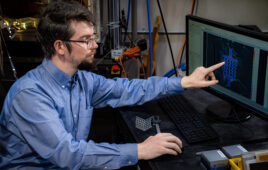 Google’s self-driving cars could receive a unique safety feature soon.
Google’s self-driving cars could receive a unique safety feature soon.
The tech giant was granted a patent last week that essentially resembles human flypaper, according to The Verge. The concept entails attaching a layer of adhesive material to the front of the car so pedestrians will simply stick to the front of the vehicle in case of a collision.
Numerous crash injuries occur when a pedestrian is thrown to the ground after the initial impact therefore this patent would limit any extenuating damage.
Also, the patent application highlights an intriguing element built into the material. Engineers will attach an exterior covering that would shield the adhesive section from becoming cluttered with foreign particles, like dust or insects. It would instantly break apart, though, exposing the adhesive layer in the event of a collision.
Licensing this invention could be one way Google ensures its self-driving cars will be safe on the road.
A report from The National Highway Traffic Safety Administrated explained 94 percent of car crashes are caused by human-error-related issues, such as distracted or drunk driving. Companies like Google and Uber are trying to sell autonomous vehicles as safer transportation alternatives, especially for the elderly or disabled.
However, there’s no guarantee strategies like this patent are fool-proof-safety mechanisms. Some reports have suggested it could take years of thorough testing to collect enough information to determine if these new vehicles are truly safer than the human-driven ones.
Plus, The Mercury News noted that this flypaper tool could cause new issues too.
Bryant Walker, an affiliate scholar with Stanford Law School’s Center for Internet & Society, told the newspaper there’s a risk that this patent could keep a pedestrian attached to the car obscuring visibility.
Still, he added that Google should be praised for considering the safety of individuals other than the people driving in the car.




